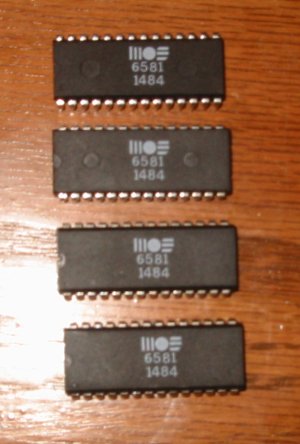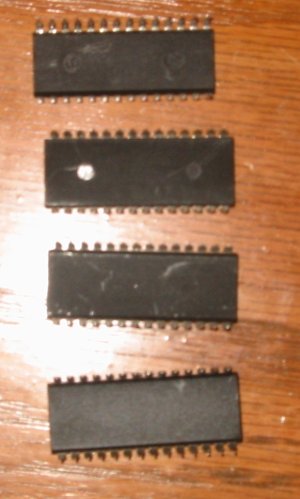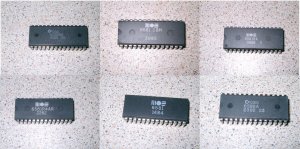Click on any picture for a larger view.

UPDATE:
I received 6 more SID chips today. I had bought them before figuring out the first four were fakes. I received two more of the 1484 fakes, and two of the 3686 fakes, and two of the 3085 fakes (the number being the chip's date code).

Like the other four, these are as phony as can be, but the job of faking them is ALOT better. The quality of these fakes is much better than the first batch I looked at. However, it is still easy to tell these have been doctored up.
First up are the chips marked "6581 CBM / 3085". Unlike the first chips I looked at, the bottoms of these were not painted over. Inspecting the bottoms however easily bears out that these are not what they appear to be. One is an R2 chip while the other is an R3 chip. Both were made on widely different dates yet the tops show the same date. Checking the top, it's easy to see that they were painted as before, and a new marking applied. The markings are better than the other fakes this time- the paint is a silver colour now, instead of being grey. However, I have a real chip marked in a similar fashion and it's easy to see that there is a difference. The marking on the fakes is perfect- the lines are straight and smooth. The real parts have a slight smudging effect to them. The real chip is on the right, the remarked parts on the left.

Second, were the chips marked "6581R4 / 3686 S". Again, the markings are pretty decent. Unfortunately I don't have a real R4 to compare to. These were pretty much identical to the two above chips, except the markings on top were different. As before I happened to get an R2 and an R3 SID. Finally, I got two more of the original chips marked "6581 / 1484", with black paint on the back side. One of the frigging chips had been DESOLDERED from a PCB. It was pretty obvious because the leads were considerably shorter than normal, and there were little traces of solder left on them!

So, that's the "new" chips I got in. Out of these 6 chips, 4 of them had totally non-working filters, while the other two had grossly defective filters. One whistles like a canary, and the other is heavily distorted. Ironically it was the two chips with the 1484 date codes that had the partially working filters. As before, the unfiltered mode on 5 of these 6 chips worked, the 6th chip had a missing channel too. One the chips where the filter is totally dead, the volume level is significantly lower than normal when the filter is turned on, since the DC level is upset. If a tune turns the filter on and off, you will hear some loud pops when it occurs.
Here's the list of SID chips I have gotten from him that were remarked/bad:
# top marking bottom marking real chip revision notes
-------------------------------------------------------------------
1 6581 CBM 3085 AH373567 KOREA (R2)
2 6581 CBM 3085 AH265885 3 KOREA (R3)
3 6581R4AR 3686 S AH325115 KOREA (R2)
4 6581R4AR 3686 S AH391860 3 KOREA (R3)
5 6581 1484 (painted) (KOREA) (unknown)
6 6581 1484 (painted) (THAILAND) (unknown)
7 sanded off sanded off (THAILAND) (R2) - this was marked "6581 / 1484"
8 sanded off TH162108 THAILAND (R2) - this was marked "6581 / 1484"
9 6581 ??84 AH513662 KOREA (R2) - this was marked "6581 / 1484"
10 6581 2284 GH092102 TAIWAN (R2) - this was marked "6581 / 1484"
The last 4 chips are the ones I removed the paint from.
All four had been sanded, but the Thailand ones had it the worst since
the chips were smooth to begin with. In the case of the other two 1484 chips,
I did not strip the paint from them but I could easily tell which fab made
them by the package details. Each fab's packaging line was slightly different
for some reason. This is good since it made it very easy to tell which
country the chips were from.
I generated a 1 minute test file for each SID chip, and two controls out of my stockpile. I used track 1 of "Castlevania 64 Remixes" since it does quite a few filter tricks.
Control #1 (R2 SID)
Control #2 (R4AR SID)
Bad SID #1 (lowpass filter nonworking)
Bad SID #2 (filter dead)
Bad SID #3 (filter + 1 chan dead)
Bad SID #4 (filter dead)
Bad SID #5 (filter distorted)
Bad SID #6 (canary caught in the filter)
Bad SID #7 (filter works, but highly distorted)
Bad SID #8 (filter dead)
Bad SID #9 (occasional filter feedback)
Bad SID #10 (filter dead)
On the chips marked "filter dead", the follow effect manifests itself:
Control (R4AR SID, good)
Bad SIDs (various)
One other interesting thing about these SIDs with the dead filters is that the audio level is very low, compared to a normal SID. All of the samples above were taken with th exact same hardware, same capacitors, same levels, etc.
And I now return you to the webpage, already in progress... (note: I added another picture at the bottom with more date codes of chips).
...
I recently acquired some SID chips that were sold as being brand new, old stock... However, they turned out to be anything but. I popped one of them into my SIDMan, and played a tune that uses filters. Instead of hearing music I heard some popping noises, and then bits of music here and there. Turns out, the filter is blown on this "brand new" SID chip. Sooo, I popped another chip in and it works but the filter sounds crummy, like it's muffled. I pop in a 3rd chip of the four, and it works but the filter is all distorted and crackly- definitely not right. The fourth is like the first- the filter is dead on it also. I was surprised that of the two that worked, the filters sounded totally different. You'd think that two chips made at the same time would sound alike, right?


Look at the chips closely. Something immediately caught my eye. Why did these supposid "new" chips come in three slightly different package styles? When you buy new chips, all of them look identical usually- they do not have different sized ejector pin markings (the two circular "dents" in the top and bottom) or pin 1 designations. Some have the cut in them only, some have the cut and a dot near pin 1.
On the bottom, some have a cavity number (the number or letter in the ejector pin depression) indicating which cavity of the mold it came out of. Two of the chips don't even have the pin marks at all! Oh, and what is odd about the bottom of these chips? I checked out 12 other SID chips I owned. Every single one of them has a wafer tracability code and country of manufacture on it. These four were blank.

After noticing the package differences, I looked closer. The chip pins were nice and bright and shiny, and bent outward like you'd find on brand new chips. I then got my micrometer out and decided to measure the package thickness since I thought they might have been ground down before remarking. Upon inspection, the chips measured out at 0.152" thick. For reference, I measured some normal SID chips of the same package style and they mic'd out at 0.149 and 0.150. Soo, our suspects are 2 mils thicker than normal. After that, I figured the chips might have been painted with black paint before remarking.
I busted out the acetone and it didn't take long to realize I was right!

Just one swipe with an acetone soaked Q-tip and the paint just came right off like
nothing. On a real chip, the markings should not come out very easily; it's usually an epoxy based paint and acetone will not attack it so readily.

Using the paper towels soaked in acetone, the rest of the paint came off easily, revealing the original SID marking! yep, this is for sure an old part, remarked.
This particular part is marked with a date of 2284 and has a Taiwan stamp on the bottom.

I then attacked the other 3 SIDs with the acetone and cleaned the paint off.

Sorry the pics are kinda crummy, the camera is poor at closeups. The bottoms show various fabs, Thailand at the top, Korea in the middle, and Thailand again at the bottom.

And here are the remarked fakes vs. the real chips. I did not have a SID made in Taiwan so the bottom one doesn't have a mate. You can mostly see the markings in the right light on the chips but the camera didn't pick it up very well. Note that the package types match exactly.

Aaand the bottom. The countries are visible on some of the remarked parts.
So, this makes me wonder... Where did all these old, bad SID chips come from? There's HUNDREDS of them being sold on ebay right now. They are very professionally remarked: The painting is flawless and textured to look like a standard IC package; the marking is a good solid print like you'd find on a real chip, complete with MOS logo. The pins were bent back out and given a fresh tin/solder dip so they were shiny and new.
The only flaw is I suspect EVERY single one of them is defective in some way. The filters were shot on all four I had gotten, while the rest of the chip worked. If you were to pop one of these into your C64, you might not notice that the filter is defective for a very long time. Most games don't use the filter at all or sparingly so it would not be missed. The filter is the first thing I tested, however.
So, telling the bad chips apart from real ones is very easy. The remarked chips all have the same date code on them, and one thing was a tipoff as to their fakeness of them.
* MOS 6581 / 1484
* MOS 6581 CBM / 3085
* MOS 6581R4AR / 2282 (obvious fake- the R4AR didn't come out until mid '86!)
* MOS 6581R4 / 3686 S
The seller is/was also selling chips with these date codes, but I do not have them so I cannot tell if they are fake, but I suspect at least the 6581 is.
* MOS 6581 CBM / 2385
* CSG 6582A / 2392 25
* CSG 8580R5 / 4091 25
Here's a collage of the 6 kinds he has been selling. LOL at the fake R4AR's.

|



